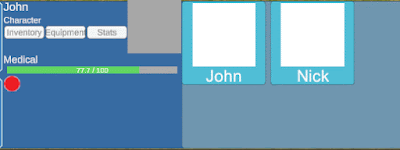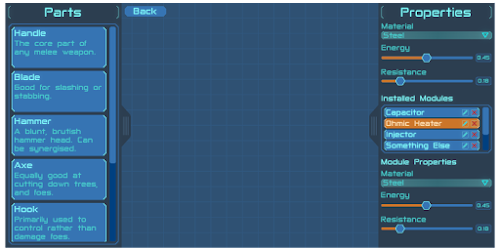January 2020 W3: Degrading Conditions & Modding
Week 3 marks the completion of the core injury and condition systems. They are now in a functional state simply awaiting content and further light tweaking. The medical system still needs tending, surgery, limb removal, and cybernetics added to the mix which I will continue hacking away at over the next 1-2 weeks.
A significant realisation I've come to is that I've been approaching character action development incorrectly. It occured to me that I should have been building the functionality for characters interacting with systems (eg. workshops for crafting) as I built the systems, not in one big later pass. Thankfully the amount of interactable systems currently completed is relatively low, so I can fairly easily rectify this.
Completed State of Injuries & Conditions
 |
| A condition degrading into a less severe condition |
Conditions can now be arbitrarily stacked in a 'parent-child-esque' relationship triggered by the duration ending on the parent condition. Any number of children can be assigned to a parent, and the hierarchy can be arbitrarily deep. The primary use for this is allowing for long lasting conditions that don't necessarily have a constant severity, such as allowing heavy bleeding to slow over time. The above gif shows a 2 deep hierarchy going from moderate to light bleeding, each with a 3 second duration for testing purposes.
Overriding Injuries
 |
| A character with the maximum number of overriding injuries cannot recieve any more injuries |
The injury assignment system is finally at a point where I'd consider it pretty much complete. There are now two types of injuries: overriding and non-overriding. An overriding injury means that no other injury can exist on the same part as it at the same time. This is meant to simulate more severe injuries that essentially make all others redundant; like how you wouldn't care about a gash on your arm if it were already mutilated - it has no real effect.
Gameplay wise, if all parts are filled with overriding injuries (Ie. there are no valid injury assignments remaining) the character will die. That said, it is incredibly unlikely that a character would get to that point. As you can see above, John only managed that after being well into negative HP.
Modding Astraeus
I've mentioned in the last couple blog posts working with JSON to allow more dynamic content loading and creation. I'm quite happy with the systems I've implemented it in, but it's become readily apparent that JSON will not cut it for all types of content. For example, content that requires unique functionality such as adding different types of conditions (eg. stunned/blinded, which have different effects to 'bleeding').
This is why I want to switch to a hybrid system. JSON works well for simple data structures such as injuries, or body definitions (races) but for conditions, (future)psionic abilities, and item definitions, a scripting solution is necessary. I considered integrating a language such as S# (Which already has compatibility with .Net, unsurprisingly) however, interpreted scripting languages come with a performance drawback, and do not provide enough useful functionality to justify that.
Instead, I'm looking towards using runtime loaded user assemblies, allowing users to interface directly with the game's code and add any functionality or content they have the ability to program.
I'm absolutely certain this will require reconsideration of my current methodology, but given a successful funding round at some point in the future, I think it's certainly on the cards.


Comments
Post a Comment